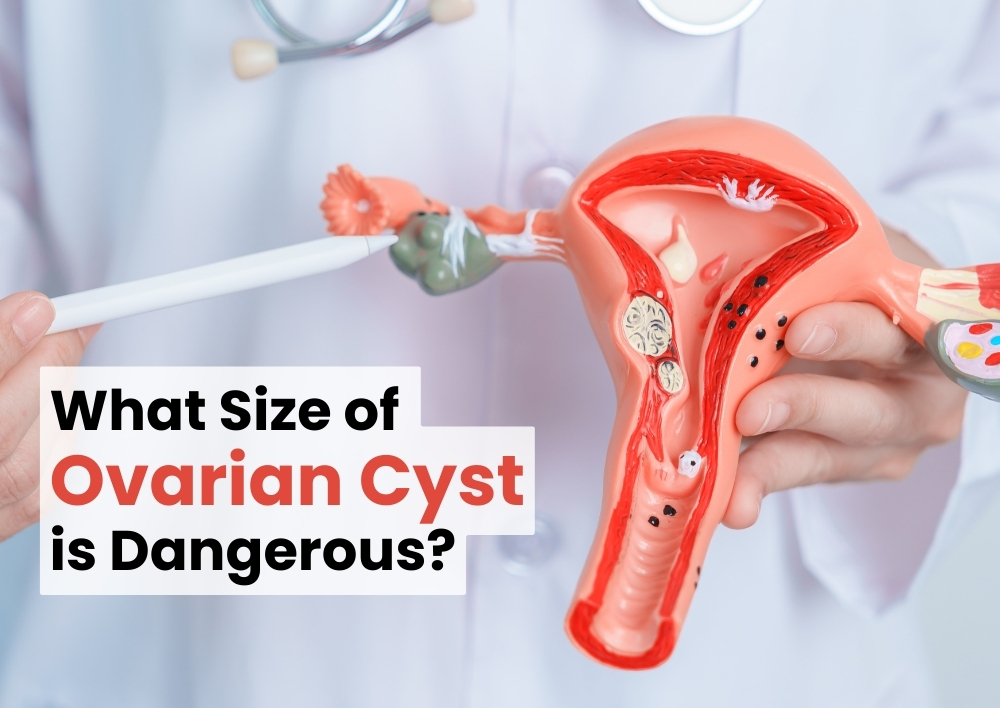What Size of Ovarian Cyst Is Dangerous?
Summary
Ovarian cysts commonly occur in women of reproductive age. While several cysts are harmless and usually go unnoticed, some can cause discomfort, pain, or serious health complications. One of the most frequently asked questions by females is “What ovarian cyst size is dangerous?” Understanding the size of a cyst, and its possible risks is important for timely medical intervention. This blog will discuss the different ovarian cyst sizes of size, the potential risks associated with larger cysts, and their symptoms to look out for.
What Are Ovarian Cysts?
According to the best Gynaecologist Doctor in Gurgaon at Miracles Apollo Cradle, Ovarian cysts are fluid-filled cysts on or inside the ovaries. The normal size of ovarian cysts in mm is less than 5. There are generally two types of ovarian cysts:
-
Functional cysts: These are the most common and are usually related to the menstrual cycle. They generally resolve on their own without causing any harm.
-
Pathological cysts: These cysts are not related to the menstrual cycle and may be benign or malignant. They require close monitoring and, in some cases, surgical removal.
Understanding the Size of Ovarian Cysts
Ovarian cysts can range in size from a few mm to several cm in diameter. The size of a cyst is an important factor in determining whether it could be harmful. Usually, cysts that are smaller than 5 cm in diameter are considered less risky and are often managed with conservative treatment. However, as the ovarian cyst size increases, complications also increase.
Here’s an overview of cyst sizes and their potential risks:
-
Small cysts (less than 5 cm): These are usually functional cysts and this typical size of ovarian cysts resolve on their own. Most women don't experience any symptoms or require treatment.
-
Medium-sized cysts (5-10 cm): These cysts may still be harmless, but they warrant more frequent monitoring. They can cause mild symptoms such as pelvic pain or discomfort during intercourse.
-
Large cysts (more than 10 cm): Larger cysts have a higher chance of causing complications, including rupture, torsion, or pressure on nearby organs. Surgical intervention is usually considered at this size.
-
Giant cysts (greater than 15 cm): This size of cysts is rare but can lead to complicated health risks. They may cause severe pain, bloating, and difficulty breathing. Immediate medical attention is necessary.
When Does Size Become Dangerous?
While ovarian cysts smaller than 5 cm are usually benign and resolve on their own, those larger than 10 cm are more prone to lead to complications such as:
-
Risk of Rupture: Larger cysts are more prone to rupturing. When a cyst ruptures, it can release its contents into the abdominal cavity, causing severe pain and, in some cases, internal bleeding. A ruptured cyst may also increase the possibility of infection, which requires immediate medical intervention.
-
Ovarian Torsion: Larger cysts can cause ovarian torsion (the ovary to twist on itself). This can cut off the blood supply to the ovary, leading to tissue death. Ovarian torsion is a medical emergency that requires surgical intervention to untwist the ovary and, in some cases, remove the cyst.
-
Pressure on Other Organs: A large-sized ovarian cyst can put pressure on its surrounding organs, such as the bladder or bowel. This can cause symptoms such as frequent urination, constipation, or a feeling of fullness even after eating small amounts.
-
Malignancy: While most ovarian cysts are benign, the chance of cancer increases with the size of the cyst, especially in postmenopausal females. Larger cysts are more likely to be pathological and require a thorough evaluation by a gynae-oncologist.
Symptoms of a Dangerous Ovarian Cyst
Many ovarian cysts go unnoticed because they do not cause any symptoms. However, as the cyst grows in size, it may start to show noticeable symptoms. So, it’s important to be aware of these signs and seek medical attention if you experience any of the following:
-
Pelvic Pain: Constant or severe pelvic pain, especially on one side, may indicate a large or problematic cyst. The pain in the pelvic area may come and go or be constant.
-
Abdominal Bloating: A large cyst can cause the abdomen to swell, leading to a feeling of fullness or bloating.
-
Difficulty Urinating or Bowel Movements: Pressure from a large cyst on the bladder or bowel may cause discomfort, frequent urination, or constipation.
-
Pain During Intercourse: A cyst may cause pain or discomfort during sexual intercourse, especially if the cyst has grown larger.
-
Changes in Menstrual Cycle: Abnormal bleeding or missed periods could be a sign of an ovarian cyst disturbing the normal hormonal balance.
-
Severe Pain with Fever or Vomiting: If you experience sharp, sudden pain along with fever, vomiting, or dizziness, it could indicate a ruptured cyst or ovarian torsion. This requires immediate medical attention.
How Are Ovarian Cysts Diagnosed?
If you suspect you have an ovarian cyst, your gynecologist may recommend an ultrasound to determine its size, location, and type. Blood tests, such as the CA-125 test, beta hCG, LDH may also be done to rule out ovarian cancer, especially in postmenopausal women or those with a family history of ovarian cancer or breast cancer.
Treatment Options for Ovarian Cysts
The treatment for an ovarian cyst largely depends on its size, type, and the symptoms it is causing. Here are some common treatment options:
-
Watchful Waiting: Small cysts that are not causing symptoms are usually monitored through regular ultrasounds. In many cases, these cysts resolve on their own without any intervention.
-
Medications: Birth control pills or hormonal treatments may be prescribed to regulate the menstrual cycle and prevent the formation of new cysts.
-
Surgery: Larger cysts or those causing symptoms may need to be surgically removed. There are two types of surgical procedures for ovarian cysts:
-
Laparoscopy: It is a minimally invasive procedure that is used to remove small to medium-sized cysts. The laparoscopic procedure involves making small incisions in the abdomen to insert a camera and surgical instruments.
-
Open Surgery: A more extensive surgery used for larger cysts, which involves making a larger incision to access and remove the cyst.
-
Conclusion:
While many ovarian cysts are harmless and resolve on their own, it’s important to monitor any changes in your body. A cyst larger than 10 cm is more likely to cause complications and may require medical intervention. If you experience constant pelvic pain, bloating, or changes in your menstrual cycle, consult a gynaecologist near you at Miracles Healthcare for a thorough evaluation.
Frequently Asked Questions
Ovarian cysts are commonly caused by hormonal changes, ovulation, endometriosis, or pelvic infections.
Most ovarian cysts are harmless and resolve on their own, but some can cause pain, rupture, or affect fertility if untreated.
Treatment depends on the type and size; options include watchful waiting, hormonal therapy, or surgical removal if needed.
Yes, many women with ovarian cysts can still conceive, though some cysts like endometriomas or PCOS may impact fertility.
A 4 cm cyst is considered small to moderate in size and is often monitored unless symptoms occur.
Cysts larger than 5 cm, especially those that are persistent or complex, may be considered potentially harmful and require further evaluation.
Miracles Apollo Cradle, Gurgaon has a team of the best gynecologists with expertise in diagnosing and treating ovarian cysts using advanced methods and personalized care.
















Was the information useful?
67 0